Editorial
I know many Model Engine News readers have been following the Cirrus Mk I project. By rough count, the engine requires 68 holes to be tapped. Twenty are 4-40, the remainder are 2-56. Drilling and tapping the four 4-40 holes used for engine mounting had been put off for some good but long forgotten reason. With everything finished and heat-treated as required, the crankshaft spinning nicely in its bearings and the camshaft rotating smoothly, it was time to drill and tap those last four holes and begin final assembly.
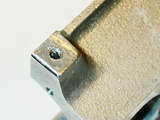
This month I will commence construction of a simple Spark Erosion Machine. Why? You guessed it. A broken tap in the VERY LAST HOLE!!! My fault. I even said to myself, "hmmmm... this tap needs sharpening". But I pressed on, taking extra care for all the good that did until the inevitable "ting!" Oh well, I knew I'd have to make one of those things one day. Very complex stepper motor-based versions have been serialized in Home Shop Machinist (HSM), Strictly Internal Combustion (SIC), and Model Engineers' Workshop (MEW). Briefly, sophisticated control electronics drive the stepper-motor to lower and raise an electrode thus causing a charged capacitor bank to spark over to the work target. This removes a minute amount of metal with each spark. The control electronics must drive the stepper motor, sensing how much and when to move the electrode to maintain the sparking action. All of these construction series spent more time describing how to make printed circuit boards than how to set-up and use the machine.
MEW has also published two vastly simpler designs based on a reclaimed VCR solenoid (the first in issue 104, the other in 107). These just drop the electrode under gravity, than snatch it back up with the solenoid. The depth of cut before manual intervention is required is small—about 2mm—but I hope the device can be completed in weeks instead of months. Time will tell. Overall, I'm amazed at how calm I am about the whole mess!
To business: this month we are able to set the record straight on a couple of subjects. One requires Yet Another update to the Motor Boys Plan Book. The other presents more material on CIE .10 diesel—which may have been the first commercial diesel to be made in the USA—than has previously been gathered in one place. We also look at another Unusual IC Engine through ETW's keen eyes and critique an old engine for home construction from 1969. There's a good collection of news items, links, Gallery entries, and another Watzit to keep you busy. Meanwhile I'm off hunting a dead VCR...
MBI Plan Book Update
Roger Schroeder's Mancini is progressing and continues to highlight the danger of publishing a set of plans that have not been proven by building an engine from them. Back in August we described how to modify the rod-swing slot in the Mancini crankcase so the engine could be actually assembled. Forget it! This month we need to describe another mod to the same area that obliterates the August mod. Without this latest change, the engine won't actually turn over! I faithfully copied an ancient drawing when CAD'ing the Mancini, but it turns out that that engine could not be assembled either.
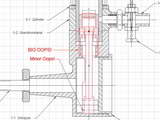 As you can see in this alteration to the GA, if built to the plans, the piston stood no chance of reaching BDC. There are two cures, shorten the piston, or bore out the case to clear the piston. The piston is very long. In the early days of model compression ignition engines there was a theory held by Lawrence Sparey and others that a long piston stood a better chance of preventing compression leakage in an amateur built engine than a short one and this was worth the extra friction the increased surface area caused. Given the refined techniques we use today to hone/lap pistons, this is no longer true—if it ever was—but changing the piston length changes the inlet timing in a "side port" engine and we'd need to raise the inlet. This is not practical, so we must bore out the case.
As you can see in this alteration to the GA, if built to the plans, the piston stood no chance of reaching BDC. There are two cures, shorten the piston, or bore out the case to clear the piston. The piston is very long. In the early days of model compression ignition engines there was a theory held by Lawrence Sparey and others that a long piston stood a better chance of preventing compression leakage in an amateur built engine than a short one and this was worth the extra friction the increased surface area caused. Given the refined techniques we use today to hone/lap pistons, this is no longer true—if it ever was—but changing the piston length changes the inlet timing in a "side port" engine and we'd need to raise the inlet. This is not practical, so we must bore out the case.
The CAD model shows that conrod clearance at BDC is marginal, so relieving the case bore to the depth of the thread in the rod area is a good idea too. This also provides a run-out area for cutting the thread. A spacer, or pad on the crank to prevent the rod rubbing on the counter-balance would not hurt either.
I've prepared replacement drawings for the Crankcase (Sheet 1) and General Arrangement (Sheet 4). These are available in PDF format for printing or download from the MBI Book page.
And re-visit the Roger Schroeder Tribute Page to see the neat little Mills P75 built by Jim Woodside from Roger's kit. Jim says that it's green in honour of the Myford it was made on  .
.
More Pascoe Perfection
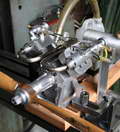
Tom Pascoe has created Yet Another Original Masterpiece. If you do a Site Search on Pascoe, you'll fine his Beare 6-stroke and a plethora of sleeve-valve configurations. Taking a break from sleeves, Tom's latest is a 90° four-stroke, V-twin that utilizes rotary valves. You'll find the pictures and story of this engine in the Gallery. Thanks go to Motor Boy Ken Croft for the photos and accompanying text.
Cirrus Progress
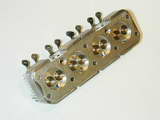
or lack thereof.. As suspected, even though all the parts are complete, assembly and sorting of fits for free movement is taking time. The valve guides have been pressed in and the valves assembled with their springs, caps, clips, and rockers. Remarkably, all seem to seat and seal quite well. The center bearing of the crankshaft gave some trouble. I knew that I should have "normalized" the crank blank after roughing it out—so why didn't I? In the years since it was turned, just enough warpage has crept in to make the center bearing bind more than I'd like. While it turned, it had an annoying tight spot when the bearing shells were clamped up. I figured the center journal needed maybe 0.0005" removed. While deciding on the best way to do this, a very kind and generous reader offered me some flexible diamond abrasive paper in 15 and 30 micron grades, and shipped it to me by UPS. This was just the ticket and the shaft now revolves smoothly.
ETW: Engines That Work
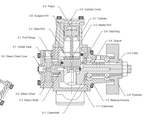
So said Westbury himself in response to his detractors following publication of his Cygnet Royal self-starting, 3-cylinder radial steam engine with orbital valve. The passion and vitriol frequently exhibited by domestic British letter writers to the Model Engineer is a source of wonder and amusement to me—although I suspect that editors, knowing controversy sells, favour such letters for publication. The letter writers are probably equally canny. Americans and Kiwis don't indulge in this; they are too polite. Australians don't either, favoring a "...it's too bloody hot, mate" philosophy. Anyway, I spotted this little jewel and wanted to share it. The target was the simplified conrod setup of the engine that results in two of the rods being offset from their cylinder centerlines. Sacrilege! Blasphemy! We must fight a duel! Coming under heavy fire, ETW relented and published a slipper big-end design revision to silence the critics and quipped that his designs favored pragmatism over purism. In other words ETW stands for Engine That Work.
Craftsmanship Museum Seal Project
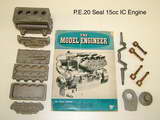
We Motor Boys like to think that we "invented" the concept of Internet Collaboration for Engine Manufacture (IC-EM™  ) back in '96. Maybe we even did, but regardless, it can be a workable process, if not a fast one. So we are pleased to see that The Internet Craftsmanship Museum has launched a project to build an ETW Seal using this approach. The Seal was serialized in the Model Engineer starting in March 1947 (while I was busy being born). It is a 15cc, four cylinder, side-valve, water-cooled, four-stroke, spark-ignition engine. The Museum is run by the Joe Martin Foundation for Exceptional Craftsmanship. Joe Martin, you may recall, is the driving force behind Sherline Products, the makers of tabletop machine tools. His book, Tabletop Machining, got a very positive review here back in September 2002.
) back in '96. Maybe we even did, but regardless, it can be a workable process, if not a fast one. So we are pleased to see that The Internet Craftsmanship Museum has launched a project to build an ETW Seal using this approach. The Seal was serialized in the Model Engineer starting in March 1947 (while I was busy being born). It is a 15cc, four cylinder, side-valve, water-cooled, four-stroke, spark-ignition engine. The Museum is run by the Joe Martin Foundation for Exceptional Craftsmanship. Joe Martin, you may recall, is the driving force behind Sherline Products, the makers of tabletop machine tools. His book, Tabletop Machining, got a very positive review here back in September 2002.
And that, dear Reader, must be a new record for the most hyperlinks in one paragraph—with only two of them to this site! Joe and his staff plan on web-casting the first run, live as it happens. When completed, the engine will go on permanent display with a plaque crediting all who contributed to its construction. That's a fine idea and your chance for a small slice of immortality. Visit the links to view progress and find out how to participate.
The Loyal Poppet-valve Two-Stroke

Judging on the page hits, articles like the Inside-out Rotary from last month are quite popular. The new table of ETW Steam Engine Designs was popular too and one reader was most helpful in filling in the blanks as well as adding a couple of ETW designs I'd missed. One of these is a most unusual two-stroke that uses automatic poppet valves for both inlet and exhaust. This engine, which ETW named the Loyal has been added to the ETW IC Engine Page and the text describing its operating cycle added to the main ETW Tribute Page. The model is gigantic. 1-3/4" bore and 4" stroke giving a displacement of 9.62 cuin (a whopping 158 cc). I'm toying with a smaller model in CAD, but it will still need to be rather large for the system to be workable. Strangely, none of my texts, not even Lyle Cummins' comprehensive Internal Fire mentions the Systemé Loyal.
Incidentally, when reading the description you may spot that ETW describes the engine as having ...an effective capacity of 78cc... Hang about! A 4.45 cm bore with a 10.16 cm stroke gives twice that! Can ETW have made a mistake? Not really. Note he says effective capacity. Given that the exhaust opens at approximately one-half of the stroke, he is correct even though the actual displacement is 158cc.
Tiny Watzit

This month's Watzit comes from Bert Streigler. It's a one-off home-built, so we don't really think anyone out there will be able to offer any more information about it. Bert believes it to be the product of a demented watch-maker. If so, he was not a great believer in fine threads. Click the thumbnail picture to find out why...
Beginners' Engine—Not!
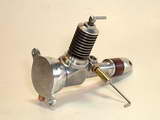
It's been a while since we dissected an engine suitable for the neophyte engine builder. Topsy has sat in the back of my mind for some time as a borderline subject that could join the other beginner designs. The picture Les Stone provided last month showing his Majesco Mite posed next to his Topsy brought the idea to the front burner and writing stated as part of the Beginner's Engine series. As I delved further into the design, I concluded that this engine was really not a suitable subject for that set of reviews, so it got split out to a page of its own that is half engine review and half engine project design review. Don't get me wrong. This is not a bad design. There are a number of features in it that I really like, in fact I may just knock one out Real Soon Now for relaxation. Visit the Topsy Page to see why I like it as an engine, but not as a Beginner project.
New Books and Magazines This Month
To those who think that the English magazine, the Model Engineer, gets disproportionate exposure in these pages, the reason is two-fold. First, it's been in continuous publication for over one hundred years on a two-week and sometimes weekly schedule, hence the volume of material guarantees some content will be of use to us. Second, and of more significance, is the quality of the contributors, past, present, and hopefully—future! And as we've observed more than once, the use of a nom de plume by many of the contributors, prolific and otherwise, is a long-standing tradition. One such contributor whom we've met in these pages before was Tubal Cain, alter-ego for TD (Tom) Walshaw, BSc (Eng), DLC (Hons), AMIMechE, AMIPE, and one-time lecturer in mechanical engineering at the University of London. Model Engine News has reviewed a few of the model engineering related books he authored under his alias, so it's well past time we looked at his more serious work.
 Diesel Engine Design was first published in 1949 by George Newness Limited. It is well and truly out of print, but a little Internet searching should find you one at a less than astronomical price, if you truly want a copy. The book is cloth bound with 448 pages containing 290 illustrations and 31 engine sections (according to the front plate). Quoting from the Preface, the book is "...based on the Author's experience as a designer, supplemented by a close study of the best British and American practice". There are 20 chapters. The first five cover necessary background topics like thermodynamics, combustion, engine types, sizes, plus general design and construction considerations. Each of the remainder is devoted to individual diesel engine components; crankshafts, valve gear, pistons, rods, injectors, etc, etc. The last chapter presents cross sections of 20 different engines ranging from a simple 23cc single cylinder engine producing 3 BHP, all the way up to a six cylinder monster that produced 200 BHP per cylinder!
Diesel Engine Design was first published in 1949 by George Newness Limited. It is well and truly out of print, but a little Internet searching should find you one at a less than astronomical price, if you truly want a copy. The book is cloth bound with 448 pages containing 290 illustrations and 31 engine sections (according to the front plate). Quoting from the Preface, the book is "...based on the Author's experience as a designer, supplemented by a close study of the best British and American practice". There are 20 chapters. The first five cover necessary background topics like thermodynamics, combustion, engine types, sizes, plus general design and construction considerations. Each of the remainder is devoted to individual diesel engine components; crankshafts, valve gear, pistons, rods, injectors, etc, etc. The last chapter presents cross sections of 20 different engines ranging from a simple 23cc single cylinder engine producing 3 BHP, all the way up to a six cylinder monster that produced 200 BHP per cylinder!
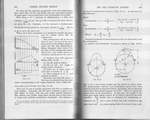 I became aware of this book some years back while researching harmonic cam design for the CamCalc program. Nested quietly in the back of Tubal Cain's book, Spring Design and Manufacture, is a page reprinted from Diesel Engine Design by one TD Walshaw. Knowledge of the connection between the two authors gave me a quiet smile while the clarity of the diagram and equations encouraged me to place the book went on the future acquisition list for The Library. The scan here shows a small taste for the coverage given to this topic.
I became aware of this book some years back while researching harmonic cam design for the CamCalc program. Nested quietly in the back of Tubal Cain's book, Spring Design and Manufacture, is a page reprinted from Diesel Engine Design by one TD Walshaw. Knowledge of the connection between the two authors gave me a quiet smile while the clarity of the diagram and equations encouraged me to place the book went on the future acquisition list for The Library. The scan here shows a small taste for the coverage given to this topic.
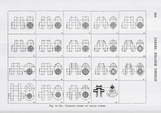 It should be obvious that this is not about model engines. The treatment requires a significant amount of math, although this is constrained to high-school level algebra and trigonometry—no calculus, not even where it would help. The first chapter deals with Thermodynamics through indicator diagrams. Constant pressure, constant volume, and mixtures of the two are clearly presented. Having got necessary theory out of the way, later chapters give clear descriptions of design choices with various rules of thumb for sound design. For example, this diagram shows a number of crank-web forms. The text lists which can be used without balance weights, which must have them, which are the lightest and most popular, which must be fabricated, etc. Another diagram provides dimensions of webs and journals related to the cylinder bore.
It should be obvious that this is not about model engines. The treatment requires a significant amount of math, although this is constrained to high-school level algebra and trigonometry—no calculus, not even where it would help. The first chapter deals with Thermodynamics through indicator diagrams. Constant pressure, constant volume, and mixtures of the two are clearly presented. Having got necessary theory out of the way, later chapters give clear descriptions of design choices with various rules of thumb for sound design. For example, this diagram shows a number of crank-web forms. The text lists which can be used without balance weights, which must have them, which are the lightest and most popular, which must be fabricated, etc. Another diagram provides dimensions of webs and journals related to the cylinder bore.
I'm delighted with Diesel Engine Design, but it's a sad fact that many people have been traumatized by math at an early age and will probably never recover, although this does not prevent them from enjoying life and making fine models. This book would be better for those who are comfortable with formulae and want a deeper understanding of what goes on in full size engines.
Engine Of The Month: The CIE .10 Diesel
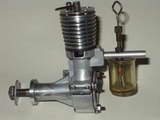
This review started out as Yet Another scan of a David Jensen review. I feel guilty over these as it's not my own work and vanity demands that I believe readers come here for my insights, not those of others. After scanning and doing the layout, I noticed something that was just plain wrong. This lead to some research in The Library and a veritable email storm within the Motor Boys group. Before I knew it, I'd added more text to the Jansen review than it originally contained and, I believe, gathered more information about this engine in one spot than has ever been gathered before. The engine is important in that it is one of the first, if not the first US made commercial compression ignition engine. Then there's the related HY-PRO and an Australian version of the CIE known as the CIA. Click on the thumbnail, or use Jansen index link above. It's even in the Engine Finder.
HEX-4

Remember the HEX-2 designed by Jerry James? Here's the next evolution of the concept. Jerry reports that it's finally running, turning an 8x6 at 7,200 rpm. A large part of getting it to run was providing adequate power to the four glow plugs. We reported on Jerry's PIC-based glow driver last month. This is now working and full details have been posted on the James Engine web site. Jerry kindly sent me a few pre-programmed PIC chips as I plan to use one of his drivers to light up the Cirrus. I have a few spares which I can post off to Australian readers in exchange for a self addressed and stamped AP padded Post-It bag. Supply, as they say, is severely limited and when they're gone, they're gone. Email me at Model Engine News for details. Readers outside Australia should contact Jerry direct (details on his web site).
Tech Tip of the Month
Don't break taps. But if you must, we'll hopefully have a cure next month.
Virtual Engine Building
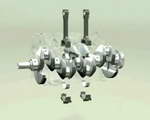
Click on the thumbnail pic to view a Flash animation of a four-cylinder in-line automobile engine being assembled. The work done in preparation of this animation is outstanding. It was apparently released by the Deutz Corporation and shame on you if you say "who?" In 1864, an inventor by the name of Nicolaus Otto partnered with mechanical engineer Eugen Langen to form N.A. Otto & Company. Their objective was to make and sell Otto's improved atmospheric gas engine, the first to employ compression. In 1867 they exhibited their engine at the Paris Exposition where to the annoyance of the French judges, it was demonstrated to consume half the fuel for the same power output as the French engines. The flood of orders this caused required they seek additional capital. This came through the investment by Hamburg businessman, Ludwig August Roosen-Runge. The new company formed in 1869 was named Langen, Otto & Roosen. But even this was not enough, so Langen convinced his brothers and their business partners to invest and on January 5, 1872, Gasmoteren-Fabrik Deutz AG came into being. "AG" stands for Aktiengesellschaft meaning a joint-stock company; the German equivalent to "Incorporated", or "Publicly Listed Company" (PLC). Otto's stockholding in Deutz was precisely zero, but unter the title of Technical Director, he devised the four-stroke cycle engine for Deutz in 1876. Otto's patents gave Deutz and their Licensees a fiercely protected monopoly during the early years of IC engine manufacture. Although the company name has undergone several minor changes, Deutz effectively spans the entire history of the four-stroke IC engine (ref: Internal Fire).
Members' CD Update
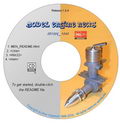
I've let this drag out far too long and due to some time-stamp irregularities caused by a global revision to use an actual "m-dash" character ("—") in place of "--", I have to issue a single zip file update of April through November 2006. At 38MB it's a bit larger than I'd like, so the bandwidth will take a hit during November. The good news is I've figured out an easy way to build the zip file, so future updates will be painless to me and more regular for you. Just login to the Members Page and grab the 0610 update.
Several Members have emailed that they like having the MEN Collection all on CD. They've not made hard disk "working copies" hence the download updates are of no real use to them. This is a valid point. So from January next year, I'll be offering registered Members an up-to-date CD, airmailed for US$10 (no cookie as there's no room), or a DVD which includes the cookie and lots of spare space for $12. Not sure what I'll do with the standard CD yet. If I update the MEN content, the cookie has to shrink and everybody loves that cookie!
By the way, Members become Members by buying the MEN CD Collection. Sales of the CD fund this web site and keep me off the streets  .
.
 MBI Plan Book Update
MBI Plan Book Update
 More Pascoe Perfection
More Pascoe Perfection
 Cirrus Progress
Cirrus Progress
 ETW: Engines That Work
ETW: Engines That Work
 The Loyal Poppet-valve Two-Stroke
The Loyal Poppet-valve Two-Stroke
 Tiny Watzit
Tiny Watzit
 Beginners' Engine—Not!
Beginners' Engine—Not!
 Craftsmanship Museum Seal Project
Craftsmanship Museum Seal Project
 HEX-4
HEX-4
 Virtual Engine Building
Virtual Engine Building
 CD Updates
CD Updates
 Editorial
Editorial
 New Books and Magazines This Month
New Books and Magazines This Month
 Engine Of The Month: CIE .10 Diesel
Engine Of The Month: CIE .10 Diesel
 Tech Tip of the Month
Tech Tip of the Month
 Standard Stuff
Standard Stuff


 .
.













